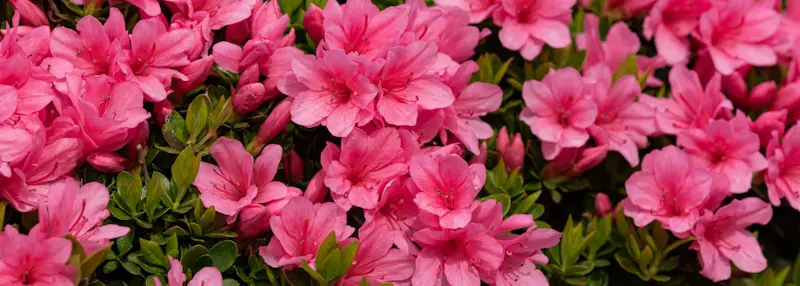Only a few plants can beat Azaleas when it comes to spectacular charm and elegance. Their beauty is unmatched with their purple, red, white, and pink blooms and uniquely shaped petals. But how big can different types of Azaleas get? Honestly, there is no right answer to this question.
The height of your Azalea depends on their variety and other factors such as location, time of planting, soil, watering, and other planting conditions. Typically, the dwarf varieties of Azaleas can reach a height of 1 foot to 3 feet, while the larger types can grow up to 12 feet.
This article will take a closer look at these varieties and how they can range from miniature pot plants to massive bushes.

Different Types Of Azaleas And How Big Can They Get?
From its vast range, choosing the right type of Azalea can be pretty challenging.
Some are indigenous to Japan, while others are common in America. You can even cross-breed different species artificially to get a plant with the best characteristics like increased height or lush green leaves.
These are some of the popular varieties of Azaleas:
Deciduous Azaleas
Native to North America, deciduous azaleas are hardy and do not require excessive winter protection.
Deciduous Azaleas are further classified into three categories according to the color of their blooms.
The White Group
Distinguished by white flowers, sometimes with blotches of other colors, the white group of azaleas is perfect for providing an elegant touch to your space.
They are primarily found in the undulating, colder regions of Canada and America and can grow anywhere between 4 and 5 feet.
The Pink Group
The “Pink Group” of deciduous azaleas is known for its flowers with interchanging pink shades. From paler hues to intense pink or even cherry red colors, these plants are as beautiful as they can get.
Their flowers usually blossom before the leaves have fully expanded, and at maturity, these plants can acquire a height from 6 to 8 feet.
The Orange Group
Standing between 8 and 10 feet, the orange group is the tallest among deciduous varieties.
The flowers of this group can experience great fluctuation in their appearance. They can lie across shades of yellow, golden, orange, or deep red, which makes them stand out.
Evergreen Azaleas
Evergreen Azaleas possess green leaves throughout the year, hence are called “Evergreen.” They do not lose their leaves, even in winter, and are native to Japan.
Evergreen Azaleas are further divided into two types: Evergreen Hybrids and Evergreen Species, and we will shine light on both of them one by one!
Evergreen Species
These naturally growing species constitute the following subgroups.
The Kyushu Group
This group is aboriginal to Kyushu, Japan, and grows high on the mounts to give a striking, colorful carpet-like appearance.
These azaleas are among the miniature varieties and grow no longer than 3 feet.
Kiusianum Azalea and Kaempferi Azalea are the two prominent members of the Kyushu Group.
- Kiusianum Azalea
Since Japan does not see much sunlight, it makes sense that these azaleas are habitual to partly sunny conditions.
Kiusianum Azaleas arrive in the form of dense, low-growing bushes, which are about 3 feet long and 1-4 feet wide.
2. Kaempferi Azalea
These azaleas can withstand strong winds and cold temperatures just like their fellow evergreen group members.
But unlike Kiusianum Azaleas, they lie on the opposite end of the height spectrum and can grow very tall, ranging from 4 feet to 10 feet.
The Indica Group
India Azalea, also known as Indian Azaleas, are notorious for producing large flowers and even larger leaves.
Their blooming season lasts for a month, mainly from March to April.
This Indica group shows remarkable heights. They can grow up to be anywhere between 6 and 10 feet.
Evergreen Hybrids
As the name indicates, these plants are genetically advanced or artificial crossbred of two different azalea types.
It includes the following types.
- Satsuki Azaleas
These short-growing, adaptive plants are hardy and can survive all climatic variations, which makes them popular.
Their blooming month is from May to June.
Talking about their height, Satsuki azaleas are 1 to 3 feet tall.
- Encore Azaleas
Plant these azaleas anywhere, and they will soon become the talk of the town. Why? Because of their unique multi-seasonal blooming abilities. Encore Azaleas can bloom during any season except winter, and to reimburse for this, they are thick and hard.
They are among the short-growing variety and do not exceed 3 feet in height. However, a few can surpass this range.
- Glenn Dale Azaleas
Glen Dale Azaleas, or what we prefer to call the “summer specialty,” is ideal for keeping your lawn vibrant under the summer sun. These azaleas bloom from March to June.
In the size department, fluctuations can occur since different plants feature different heights, but the average height of these Glenn Dale Azaleas can range between 4 and 6 feet, with a mean width of 3 to 4 feet.

Some Tips To Help Your Azalea Reach Its Full Potential
Each type of azalea can only mature into its predetermined genetic size. For example, “happy days” that are bred to grow 5 feet tall will not exceed their mark.
Additionally, some varieties are fast-growing, with a foot growth per year. In contrast, others can take a while and grow only a few inches annually.
However, you can try these tips to help your Azalea thrive and reach its full potential:
- Ensure that your azalea is hardy in your climate zone.
- Choose an appropriate location for planting your azalea. Most require dappled sun with enough shade for optimum growth, while other varieties can withstand more sun. None of the types can grow in full shade.
- Keep check of the soil. The ideal soil condition for azalea is a loamy, well-drained soil with an acidic pH of around 4.5 to 6.
- To help your azalea feel at home, you can even spread mulch around it to give that “forest floor” vibe. Aside from the homey feel, this mulch will also regulate soil temperature, provide nutrients to your plant, and keep weeds at bay.
- Azaleas need about 1 inch of water every week; therefore, ensure to water them regularly and adequately, so they do not dry out.
- Azaleas can grow pretty well in the absence of fertilizer. Hence it is not mandatory to fertilize them now and then.
Final Words
In search of an easy-to-grow, beautiful ornamental plant? If yes, then you better get your hands on these plants. With their bright flowers and succulent leaves, Azaleas can be an excellent addition to your home.
But what makes azaleas even more interesting is their extreme size variation. They can come in as small as 1 foot or as large as 12 feet!
Our article covers all the varieties and how big they can get to help you choose the next best companion for your garden!
Victoria is the owner and main author of hobby plants. She loves spending her free time in her garden planting and taking care of her plants. Victoria hopes you enjoy the content here!
![Why Is My Aloe Plant Turning Brown? [FIND OUT HERE] Why Is My Aloe Plant Turning Brown? [FIND OUT HERE]](https://www.hobbyplants.com/wp-content/uploads/2022/07/why-is-my-aloe-plant-turning-brown-300x158.jpg)
![Why Are My Bird of Paradise Leaves Curling? [FIND OUT HERE] Why Are My Bird of Paradise Leaves Curling? [FIND OUT HERE]](https://www.hobbyplants.com/wp-content/uploads/2022/07/bird-of-paradise-leaves-curling-300x158.jpg)
![Why Are My Orchid Leaves Turning Yellow? [Find Out Here] Why Are My Orchid Leaves Turning Yellow? [Find Out Here]](https://www.hobbyplants.com/wp-content/uploads/2022/07/orchid-leaves-turning-yellow-300x158.jpg)
![Why Is My Bamboo Plant Turning Yellow? [Find Out Here] Why Is My Bamboo Plant Turning Yellow? [Find Out Here]](https://www.hobbyplants.com/wp-content/uploads/2022/07/why-is-my-bamboo-turning-yellow-300x158.jpg)
![How To Propagate Bird Of Paradise? [Find Out Here] How To Propagate Bird Of Paradise? [Find Out Here]](https://www.hobbyplants.com/wp-content/uploads/2022/08/how-to-propagate-bird-of-paradise-300x158.jpg)
![How Often Do You Water A Snake Plant? [FIND OUT HERE] How Often Do You Water A Snake Plant? [FIND OUT HERE]](https://www.hobbyplants.com/wp-content/uploads/2022/07/how-often-do-you-water-a-snake-plant-1-300x158.jpg)
![What Are The Types Of Dracaena Plants [Answered] What Are The Types Of Dracaena Plants [Answered]](https://www.hobbyplants.com/wp-content/uploads/2022/07/types-of-dracaena-plants-300x158.jpg)
![The Types of Prayer Plants: [Varieties Explained] The Types of Prayer Plants: [Varieties Explained]](https://www.hobbyplants.com/wp-content/uploads/2022/09/types-of-prayer-plants-300x158.jpg)
![The Types of Ice Plants: [Varieties Explained] The Types of Ice Plants: [Varieties Explained]](https://www.hobbyplants.com/wp-content/uploads/2022/09/types-of-ice-plant-300x158.jpg)
![How To Get Rid Of White Bugs In Soil? [PLAN OF ACTION] How To Get Rid Of White Bugs In Soil? [PLAN OF ACTION]](https://www.hobbyplants.com/wp-content/uploads/2022/08/white-bugs-in-soil-300x158.jpg)

